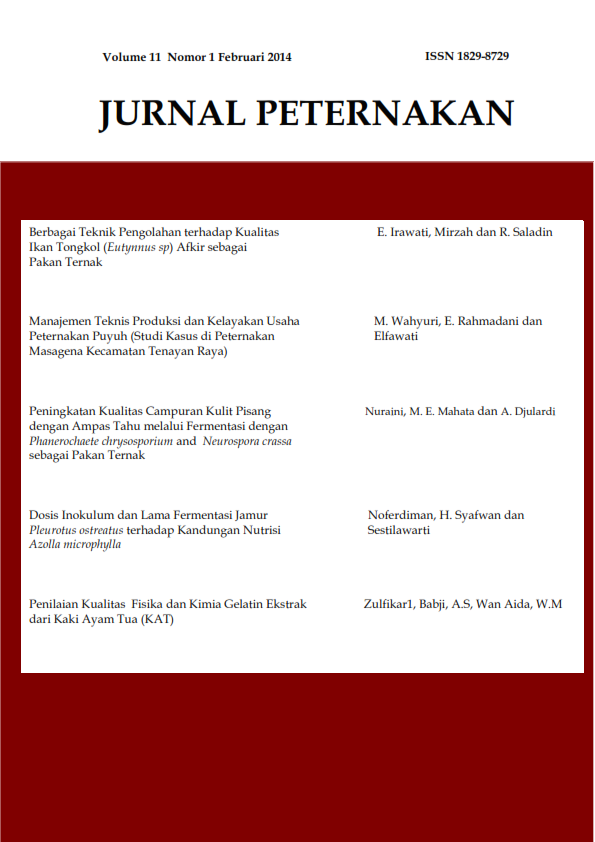DOSIS INOKULUM DAN LAMA FERMENTASI JAMUR Pleurotus ostreatus TERHADAP KANDUNGAN NUTRISI Azolla microphylla
DOI:
https://doi.org/10.24014/jupet.v11i1.2325Keywords:
fermentation, Pleurotus ostreatus and AzollaAbstract
This research aims analyze the effect of inoculum dosage of Pleurotus ostreatus and the length of fermentation on the nutritious content of Azolla. The experimental design used completely randomized design in factorial (3 x 3). The first factor is the inoculum dosage, namely : (D1). 3%, (D2).6% and (D3).9% of substrate weight. The second factor is the length of fermentation, namely : (L7). 7 days, (L14). 14 days and (L21). 21 days. Every treatment is repeated for three time. The data found is scrutinized by mode print and it is followed by distance test of multiple Duncan (Steel and Torrie, 1989). The variables observed in research are dry materials, crude fiber, crude protein, cellulose and lignin. The research on the influence of inoculum dosage and the length of fermentation on dry materials content, crude protein and cellulose had not significant effect (P>0.05). On the other hand, crude fiber,and lignin had significant effect (P<0.01). The inoculum dosage of 9% and the fermentation length of 14 days is the best combination treatment and it can reduce the crude fiber amounting to 48.80%, an increase of crude protein amounting to 39.31% and a decrease of cellulose and lignin amounting to 49.86% and 27.66% respectively.Downloads
Published
Issue
Section
License
The Authors submitting a manuscript do so on the understanding that if accepted for publication, copyright of the article shall be assigned to Jurnal Peternakan and published by Fakultas Pertanian dan Peternakan Universitas Islam Negeri Sultan Syarif Kasim Riau as publisher of the journal.
Authors who publish with this journal agree to the following terms:
Authors automatically transfer the copyright to the journal and grant the journal right of first publication with the work simultaneously licensed under a Creative Commons (CC BY) that allows others to share the work with an acknowledgement of the work's authorship and initial publication in this journal.
Authors are able to enter into separate permission for non-exclusive distribution of the journal's published version of the work (e.g., post it to an institutional repository or publish it in a book), with an acknowledgement of its initial publication in this journal.
Authors are permitted and encouraged to post their work online (e.g., in institutional repositories or on their website) prior to and during the submission process, as it can lead to productive exchanges, as well as earlier and greater citation of published work (See The Effect of Open Access).

